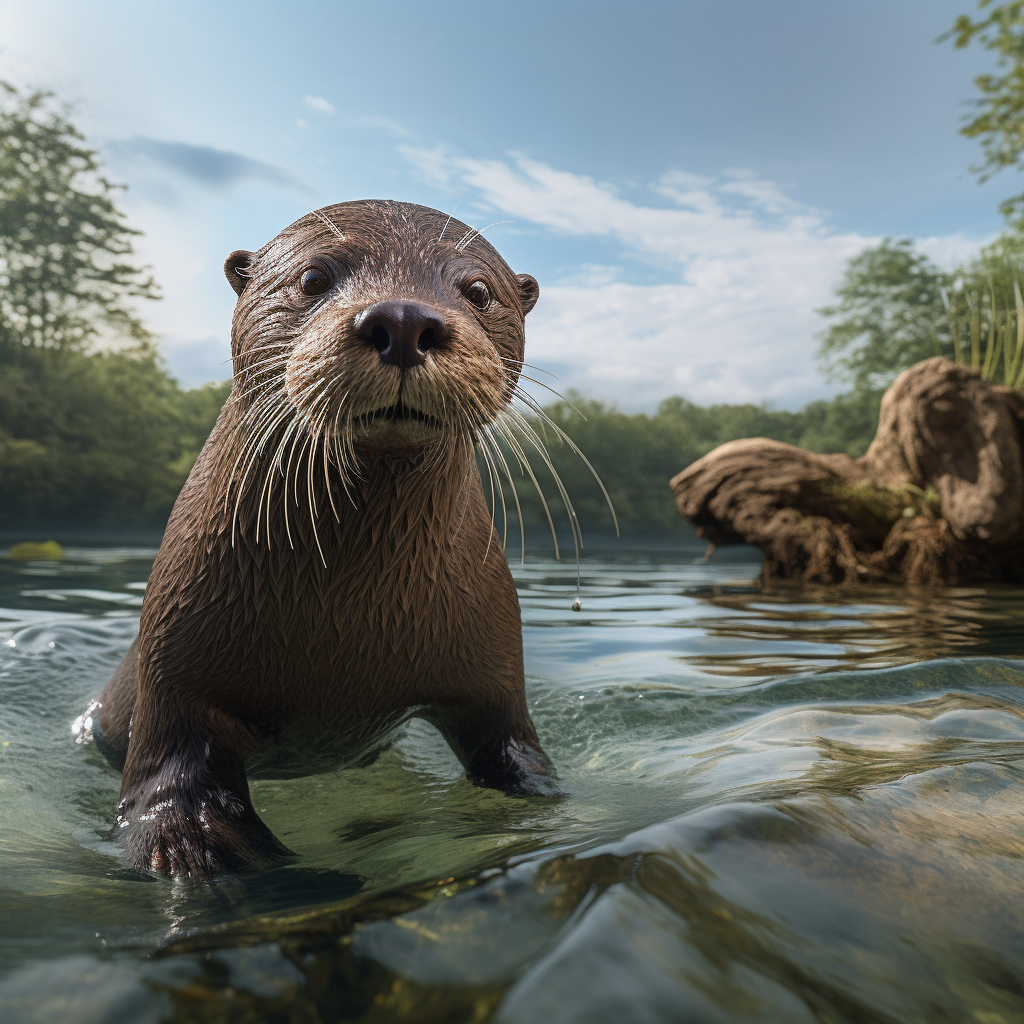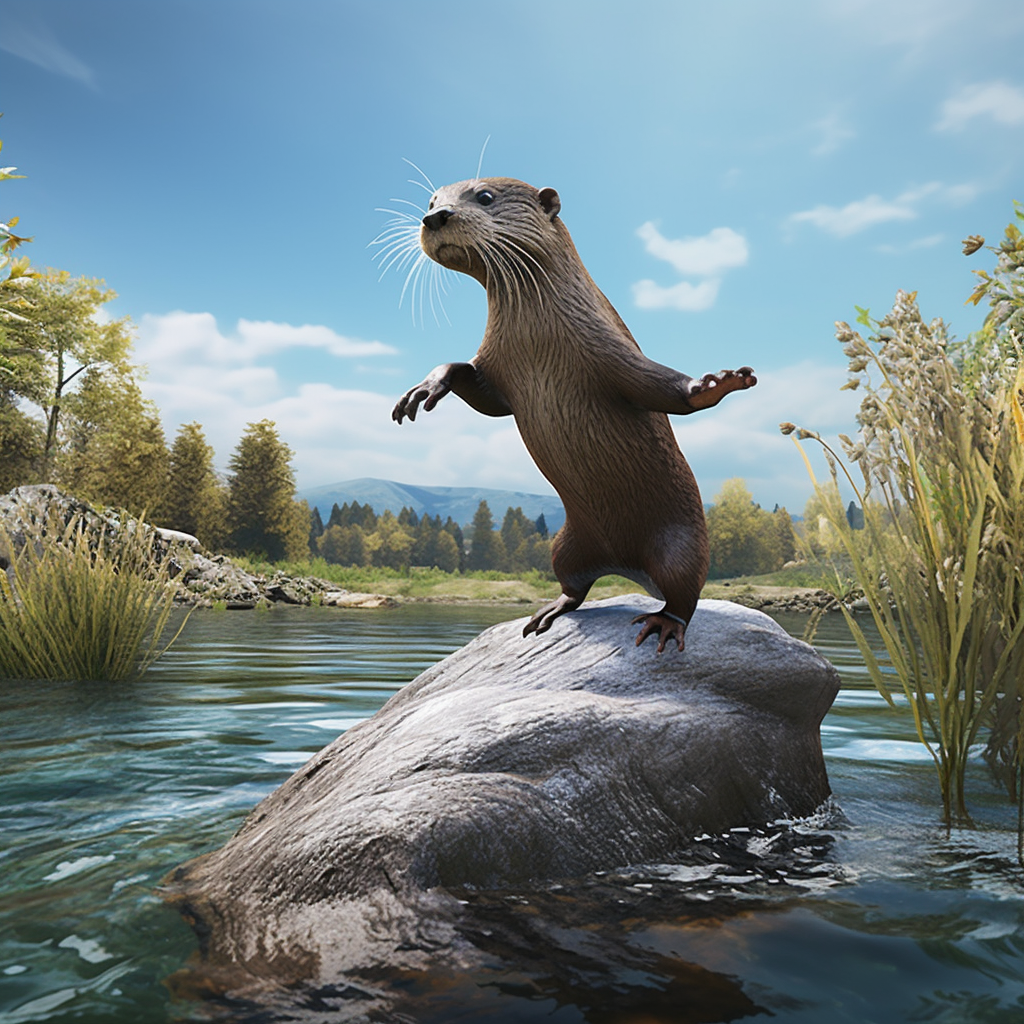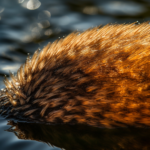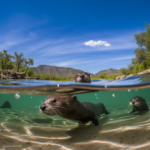River otters are fascinating creatures that inhabit freshwater ecosystems across North America. Known for their playful nature and sleek appearance, these semi-aquatic mammals have captured the hearts of many wildlife enthusiasts. But have you ever wondered just how big these otters can get? In this article, we will explore the size and dimensions of river otters, shedding light on their physical characteristics and providing insights into their impressive growth. So, let’s dive in and discover the incredible world of river otters!
Key Takeaways
- River otters can grow to be quite large, with males typically being larger than females.
- The average size of a river otter is around 3 to 4 feet in length, including the tail.
- They can weigh anywhere from 10 to 30 pounds, depending on their age and sex.
- River otters have streamlined bodies and webbed feet, which help them swim and navigate through water.
- These playful creatures are excellent swimmers and can stay underwater for several minutes at a time.
- River otters are found in various habitats, including rivers, lakes, and coastal areas, across North America.
Understanding River Otters: A Brief Overview
A. What Are River Otters?
River otters are fascinating creatures that belong to the weasel family. These semi-aquatic mammals are known for their playful nature and sleek, streamlined bodies. They are well-adapted to life in and around water, with webbed feet and a thick, water-repellent coat that keeps them warm and buoyant.
One of the most distinctive features of river otters is their long, muscular tail, which can make up almost a third of their total body length. This tail serves multiple purposes, acting as a rudder when swimming and providing balance when walking on land. It also helps them to propel through the water with ease, making them excellent swimmers.
B. Where Do River Otters Live?
River otters can be found in a variety of habitats across North America, including rivers, lakes, marshes, and coastal areas. They are highly adaptable and can thrive in both freshwater and saltwater environments.
These playful creatures are most commonly found in regions with abundant water sources, such as the Pacific Northwest, the Great Lakes region, and the Gulf Coast. They prefer areas with dense vegetation along the water’s edge, which provides cover and easy access to their food sources.
River otters are excellent swimmers and spend a significant amount of time in the water. They are known to create burrows, or dens, near the water’s edge, where they rest, give birth, and seek shelter from predators. These dens can be found in riverbanks, under fallen trees, or in abandoned beaver lodges.
River otters are highly adaptable and have even been spotted in urban areas, such as parks and golf courses, where there are suitable water sources nearby. However, they are more commonly found in undisturbed natural habitats.
In the next section, we will explore the size and physical characteristics of river otters, shedding light on just how big these fascinating creatures can get.
The Size Factor: How Big Can River Otters Get?
River otters are fascinating creatures known for their playful behavior and sleek appearance. But have you ever wondered just how big these adorable mammals can grow? In this section, we’ll explore the size variations among river otters, including the regular river otters and the giant river otters.
A. Size of Regular River Otters
Regular river otters, also known as North American river otters, are found throughout North America. These otters have a slender body shape, allowing them to glide effortlessly through the water. On average, they measure around 3 to 4 feet in length, including their tail, which accounts for about one-third of their total length.
In terms of weight, adult river otters can range from 10 to 30 pounds, with males generally being larger and heavier than females. Their size and weight can vary depending on factors such as age, habitat, and available food sources.
B. The Giant River Otters: How Big Do They Get?
While regular river otters are impressive in their own right, the giant river otters take size to a whole new level. These magnificent creatures are native to South America and are the largest otter species in the world.
Giant river otters can reach lengths of up to 6 feet, making them almost twice the size of regular river otters. Their powerful bodies can weigh between 55 and 75 pounds, with some individuals even tipping the scales at over 100 pounds. These otters have a more robust build compared to their North American counterparts, with a muscular neck and a broad head.
C. The Largest River Otter on Record
When it comes to the largest river otter ever recorded, one particular individual stands out. This exceptional otter, known as the “giant of giants,” was found in Brazil and measured a staggering 7 feet and 6 inches in length. It weighed an astonishing 126 pounds, making it the largest river otter ever documented.
It’s important to note that such exceptional sizes are rare, and most river otters fall within the average range mentioned earlier. However, these extraordinary cases highlight the incredible diversity in size that can be observed among river otters.
To summarize, regular river otters typically measure around 3 to 4 feet in length and weigh between 10 and 30 pounds. On the other hand, giant river otters can grow up to 6 feet long and weigh between 55 and 75 pounds, with some individuals exceeding 100 pounds. The largest recorded river otter measured 7 feet and 6 inches in length and weighed 126 pounds. These size variations make river otters a truly remarkable species to study and admire.
The Giant River Otters: A Closer Look
A. How Long Are Giant River Otters?
Giant river otters, also known as Pteronura brasiliensis, are the largest otter species in the world. These fascinating creatures can grow to impressive lengths. On average, adult giant river otters measure between 5.6 and 6.2 feet (1.7 to 1.9 meters) from head to tail. That’s almost as long as a tall person!
The length of a giant river otter‘s body is not the only remarkable feature. Their tails alone can measure up to 2.3 feet (0.7 meters) long. This long, muscular tail helps them navigate through the water with ease, acting as a rudder and providing stability while swimming. It’s truly a sight to behold!
B. Where Do Giant River Otters Live?
Giant river otters are primarily found in South America, specifically in the Amazon Basin and the Pantanal wetlands. These regions provide the perfect habitat for these semi-aquatic mammals, with their extensive river systems, lakes, and swamps. Giant river otters are well-adapted to their aquatic lifestyle, with webbed feet and a streamlined body that allows them to move swiftly through the water.
These otters are highly social animals and live in family groups called “holts.” A typical holt consists of an alpha male and female, their offspring, and sometimes other related adults. They are known for their strong family bonds and cooperative hunting behavior.
C. How Big Can Giant River Otters Get?
When it comes to size, giant river otters are truly impressive. On average, adult giant river otters weigh between 49 and 71 pounds (22 to 32 kilograms). That’s about the weight of a large dog! However, some individuals have been recorded weighing up to 100 pounds (45 kilograms). These otters have a robust and muscular build, making them well-suited for their active and agile lifestyle in the water.
To put their size into perspective, giant river otters are significantly larger than other otter species. For example, North American river otters, which are commonly found in North America, typically weigh between 11 and 31 pounds (5 to 14 kilograms) and measure around 3 to 4 feet (0.9 to 1.2 meters) in length. The size difference between these two species is quite remarkable.
In addition to their size, giant river otters are known for their striking appearance. They have dense, velvety fur that ranges in color from dark brown to reddish-brown. This luxurious fur helps to keep them warm in the water and provides excellent insulation.
In conclusion, giant river otters are truly remarkable creatures. Their impressive size, social behavior, and unique adaptations make them a fascinating species to study. Whether it’s their long bodies, their preferred habitats, or their large size, giant river otters never fail to capture our attention and admiration.
The Human-Otter Interaction: Are River Otters Dangerous?

A. Are River Otters Dangerous to Humans?
River otters are fascinating creatures that inhabit various waterways across North America. While they may appear cute and playful, it’s natural to wonder if they pose any danger to humans. Let’s explore the potential risks associated with human-otter interactions.
First and foremost, it’s important to note that river otters are generally not aggressive towards humans. They are curious and intelligent animals, but their primary focus is on finding food and maintaining their territory. As long as humans respect their space and observe them from a safe distance, the chances of encountering any issues are minimal.
However, it’s crucial to exercise caution when encountering river otters in the wild. Like any wild animal, they may become defensive if they feel threatened or cornered. It’s best to avoid approaching them too closely or attempting to touch or feed them. By maintaining a respectful distance, you can enjoy observing these charismatic creatures without putting yourself or the otters at risk.
In rare cases, river otters may display aggressive behavior towards humans, particularly if they have been habituated to human presence or if they feel their young are in danger. Such instances are extremely rare, but it’s always wise to err on the side of caution and give these animals the space they need to thrive.
B. Can River Otters Be Pets?
River otters are undeniably adorable, and it’s understandable why some people might be tempted to keep them as pets. However, it’s important to remember that otters are wild animals with specific needs and behaviors that are best suited to their natural habitat.
In many countries, including the United States, it is illegal to keep river otters as pets without the appropriate permits and licenses. This is because otters require specialized care and a suitable environment to thrive. They have a high energy level and need ample space to swim, play, and forage for food.
Moreover, river otters have complex social structures and are highly social animals. They thrive in groups and require interaction with their own kind for their mental and emotional well-being. Keeping a river otter as a pet would deprive them of these essential social connections and could lead to stress and behavioral issues.
Additionally, river otters have specific dietary requirements that can be challenging to meet in a domestic setting. Their diet consists mainly of fish and other aquatic prey, which can be expensive and difficult to provide consistently.
In conclusion, while river otters may seem like appealing pets, it is best to appreciate them from a distance and support conservation efforts to protect their natural habitats. By respecting their wild nature and allowing them to live freely, we can ensure the long-term survival and well-being of these remarkable creatures.
The Rarity and Conservation of River Otters

A. Are River Otters Rare?
River otters are fascinating creatures that inhabit various regions across the globe. While they may not be as commonly seen as some other animals, they are not necessarily considered rare. River otters can be found in North America, Europe, and Asia, with different species adapted to different environments.
In North America, the North American river otter (Lontra canadensis) is the most common species. These otters can be found in freshwater habitats such as rivers, lakes, and marshes. They have a wide distribution across the continent, from Alaska and Canada down to Mexico.
In Europe, the Eurasian otter (Lutra lutra) is the most prevalent species. They can be found in various aquatic habitats, including rivers, lakes, and coastal areas. Eurasian otters have a more limited distribution compared to their North American counterparts, with populations scattered across different countries.
In Asia, there are several otter species, including the smooth-coated otter (Lutrogale perspicillata) and the Asian small-clawed otter (Aonyx cinerea). These otters inhabit freshwater and coastal areas in countries such as India, Bangladesh, and Indonesia.
B. Efforts to Conserve River Otters
Conservation efforts play a crucial role in protecting river otters and their habitats. These efforts aim to ensure the survival and well-being of otter populations, as well as the ecosystems they inhabit. Here are some notable initiatives:
-
Habitat Protection: One of the primary strategies for conserving river otters is to protect their natural habitats. This involves preserving and restoring wetlands, rivers, and other freshwater ecosystems that otters rely on. By safeguarding these areas, we can help maintain healthy populations of otters and other wildlife.
-
Pollution Control: River otters are highly sensitive to water pollution. Efforts to reduce pollution, such as minimizing industrial waste and improving wastewater treatment, are essential for their conservation. By keeping waterways clean, we can create a safer environment for otters and other aquatic species.
-
Reintroduction Programs: In some regions where otter populations have declined, reintroduction programs have been implemented. These programs involve releasing captive-bred otters into suitable habitats to bolster existing populations. By reintroducing otters, we can help restore their numbers in areas where they have become scarce.
-
Education and Awareness: Raising awareness about the importance of river otters and their conservation is crucial. Educational programs, public outreach campaigns, and wildlife documentaries can help people understand the significance of otters in ecosystems and inspire them to take action to protect these charismatic creatures.
-
Collaboration and Research: Conservation efforts often involve collaboration between scientists, conservation organizations, and government agencies. Research plays a vital role in understanding otter populations, their behavior, and the threats they face. By working together and sharing knowledge, we can develop effective conservation strategies.
In conclusion, while river otters may not be considered rare, they still require conservation efforts to ensure their long-term survival. By protecting their habitats, controlling pollution, implementing reintroduction programs, raising awareness, and conducting research, we can contribute to the conservation of these remarkable aquatic mammals.
Attracting River Otters: Tips and Precautions

A. How to Attract River Otters
River otters are fascinating creatures that can bring joy and excitement to any outdoor enthusiast. If you’re interested in attracting these playful mammals to your area, here are some tips to help you create an inviting habitat for them:
-
Provide a Suitable Habitat: River otters prefer areas with clean, freshwater sources such as rivers, lakes, and marshes. Ensure that the water quality is good and the habitat is free from pollution. Creating a diverse ecosystem with plenty of vegetation, fallen logs, and rocks will also attract otters as they provide hiding places and resting spots.
-
Offer Food Sources: River otters are opportunistic feeders, so having a variety of food sources will entice them to visit. Fish, crayfish, frogs, and even small mammals like muskrats are all part of their diet. Consider stocking your water body with fish or creating a small pond where these food sources can thrive.
-
Build a Den: River otters use dens for shelter and breeding. Constructing artificial dens near the water’s edge can provide a safe space for otters to raise their young. These dens can be made from logs, rocks, or even large PVC pipes buried partially in the ground.
-
Maintain a Quiet Environment: River otters are sensitive to disturbances, so it’s important to create a peaceful atmosphere. Avoid loud noises, excessive human activity, and keep pets away from the area where you want to attract otters.
-
Be Patient: Attracting river otters may take time. It’s essential to be patient and allow them to discover the habitat you’ve created. Remember, otters are wild animals, and their presence is not guaranteed. Enjoy the process of creating a suitable environment and appreciate the other wildlife that may visit in the meantime.
B. Precautions to Take When Attracting River Otters
While attracting river otters can be a rewarding experience, it’s important to take certain precautions to ensure both your safety and the well-being of the otters:
-
Observe from a Distance: River otters are wild animals and should be observed from a safe distance. Avoid approaching them too closely, as this can cause stress and potentially lead to aggressive behavior.
-
Do Not Feed Them: Feeding wild otters can disrupt their natural foraging behavior and make them dependent on humans for food. This can lead to negative consequences for both the otters and the ecosystem. Enjoy watching them in their natural habitat without interfering with their feeding patterns.
-
Respect their Space: River otters are territorial animals, and intruding into their space can cause stress and aggression. Avoid entering their dens or disturbing their resting areas. Give them the space they need to thrive.
-
Avoid Chemicals and Pollutants: Ensure that the habitat you create for river otters is free from harmful chemicals and pollutants. Pesticides, fertilizers, and other pollutants can contaminate the water and negatively impact the otters‘ health. Opt for environmentally friendly alternatives when managing your property.
-
Educate Others: Share your knowledge and experiences with others to promote responsible wildlife viewing. Encourage others to appreciate river otters from a distance and respect their natural behaviors.
By following these tips and precautions, you can create a welcoming environment for river otters while ensuring their safety and well-being. Remember, the goal is to provide a habitat that allows these fascinating creatures to thrive in their natural surroundings. Conclusion
In conclusion, river otters are fascinating creatures that can grow to impressive sizes. These semiaquatic mammals have adapted to life in and around rivers, lakes, and wetlands, using their streamlined bodies and webbed feet to navigate through water with ease. With an average length of 3 to 4 feet and a weight of 10 to 30 pounds, river otters are larger than many people might expect. However, their size can vary depending on factors such as location, subspecies, and individual genetics. Despite their relatively small size compared to other otter species, river otters are highly skilled hunters and swimmers, capable of catching fish, amphibians, and even small mammals. Their playful nature and adorable appearance make them a favorite among wildlife enthusiasts and nature lovers. So, if you ever have the opportunity to spot a river otter in the wild, take a moment to appreciate their beauty and the incredible diversity of the animal kingdom.
Frequently Asked Questions
How to attract river otters?
Attracting river otters to your property can be a challenge as they are wild animals. However, maintaining a clean and healthy aquatic environment with plenty of fish, their primary food source, can potentially attract them. Remember, it’s important not to feed wild animals directly as it can disrupt their natural behaviors.
How long are giant river otters?
Giant river otters are the largest otters in the world. They can reach lengths of up to 5.6 feet (1.7 meters) from head to tail.
How big does a river otter get?
The size of a river otter can vary depending on the species. North American river otters, for example, typically grow to lengths of 3.3 to 4.9 feet (1 to 1.5 meters), including the tail.
How big do giant river otters get?
Giant river otters are the largest of all otter species. They can grow up to 5.6 feet (1.7 meters) long from head to tail and weigh up to 75 pounds (34 kilograms).
What is the largest river otter on record?
The largest river otter on record is a giant river otter that was 7.2 feet (2.2 meters) long. However, such large sizes are rare, with most giant river otters averaging around 5.6 feet (1.7 meters) in length.
How big can river otters get?
River otters can grow quite large, with North American river otters typically reaching lengths of 3.3 to 4.9 feet (1 to 1.5 meters), including the tail. Their weight can range from 11 to 30 pounds (5 to 14 kilograms).
How big can giant river otters get?
Giant river otters can grow to be very large, reaching lengths of up to 5.6 feet (1.7 meters) and weights of up to 75 pounds (34 kilograms).
Are river otters dangerous?
River otters are generally not dangerous to humans unless they feel threatened or cornered. They are wild animals and should be respected and observed from a distance.
Where do giant river otters live?
Giant river otters are native to South America and are typically found in the Amazon, Orinoco, and La Plata river systems. They prefer freshwater habitats like rivers, creeks, and lakes.
Can river otters be pets?
No, river otters should not be kept as pets. They are wild animals with specific needs that are difficult to meet in a domestic setting. In many places, it’s also illegal to keep them as pets without a special permit.




